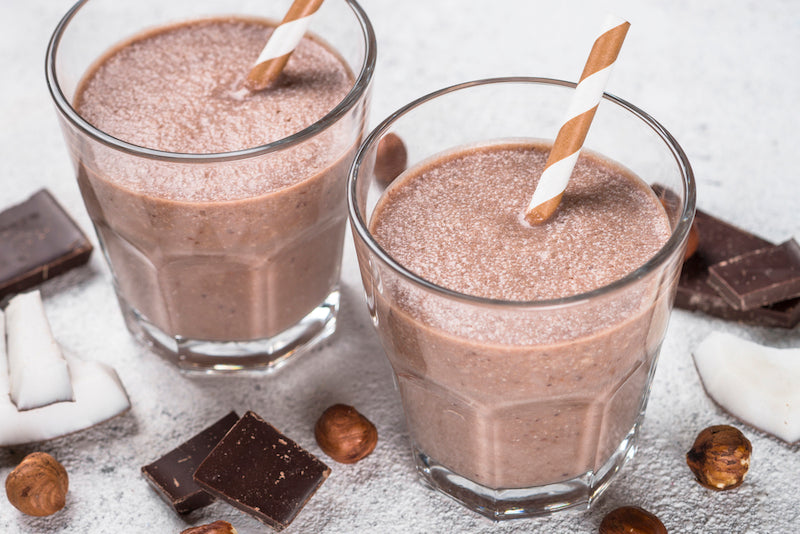Many people are striving to improve their body composition, and in particular, increase their muscle mass.
Throughout these efforts, it can be confusing to fully understand what health habits and supplement recommendations to follow for the best results.
This article will explain the science behind micellar casein and if it’s ideal for increasing muscle mass.
What is Micellar Casein?
Casein is a protein found in milk. There are two types of casein: micellar casein and casein hydrolysate.
Micellar casein is not only the more common type, but it’s also the most natural. Micellar casein’s protein structure is essentially in its original form, whereas casein hydrolysate is more processed and is already partially broken down.
Micellar casein is digested slowly into the digestive tract, which is why this type of casein allows for a steady stream of amino acids to be absorbed into the bloodstream (1).
It’s called micellar casein because when it’s consumed, the particles form small ball-like shapes called micelles. These micelles can carry and transport fat-soluble vitamins and minerals such as vitamin D, calcium, and potassium.
Is Micellar the Best Type of Casein?
The best type of casein ultimately depends on your goals.
Both micellar casein and casein hydrolysate have their unique benefits so it’s difficult to say that one is really better than the other.
In terms of processing, micellar casein is definitely the most natural and unprocessed form of casein.
Casein hydrolysate is partially broken down through chemical processing, which allows it to be absorbed and utilized by the body pretty quickly.
Micellar casein is left largely unprocessed, leaving its protein structure intact, which enables it to be digested and absorbed slowly.
This slow absorption is a huge part of what makes micellar casein so beneficial, and is really what separates the benefits of casein from the benefits of whey.

Casein vs Whey: What is the Difference
Casein and whey both come from milk, however, there are some key differences in how they’re derived and also in their health benefits.
Casein and Whey Both Come From Milk
Casein and whey are both proteins found in cow’s milk. Casein makes up 80% of the milk protein, while whey makes up the other 20% (2).
Both casein and whey are complete proteins, containing all nine essential amino acids. Essential amino acids are those that the body cannot make on its own so we must get them from food.
But How Exactly Do We Get Casein and Whey From Milk?
Casein and whey are both left behind from making cheese. The cheesemaking process involves heating milk and adding enzymes and acids. When this happens, the casein protein will turn solid and separate from the liquid milk.
The liquid portion is the whey protein, while the solid curds is the casein. Both parts are dried to form a powder, which becomes the supplements that we find on the shelves.

Slow vs Fast Releasing Protein
One of the most significant properties of a protein is how slowly or quickly it is digested and absorbed. When it comes to casein and whey, one of the biggest differences between the two is absorption time.
Once consumed, the body breaks down protein into small molecules, or amino acids, which are then released into your bloodstream.
A protein that is fast releasing will only have amino acids circulating for about 1-2 hours, while a slower-digesting protein will allow amino acids to circulate for about 4-5 hours (3).
Whey is a fast-digesting protein, meaning it will circulate only briefly, while casein is a slow-digesting protein, meaning its amino acids will remain in the bloodstream for several hours.
The slow and steady delivery of amino acids from casein is ideal for continuously fueling the muscles, even during periods of fasting (4).
Fast-digesting proteins like whey can be great for encouraging muscle protein synthesis immediately after a workout and can begin the muscle repair process (5).
Micellar Casein for Muscle Protein Synthesis
Micellar casein can play an important role in muscle protein synthesis.
Micellar casein reduces muscle and protein breakdown after a workout, and can encourage muscle growth by stimulating muscle protein synthesis. Muscle protein synthesis is a metabolic process that involves the incorporation of amino acids into skeletal muscle.
Because casein is slow-digesting, amino acids are continuously and steadily provided to muscles even hours after consuming it.
Plus, casein contains all nine essential amino acids necessary for muscle growth to occur. Of note, micellar casein is high in leucine, which is particularly vital in muscle protein synthesis (6).
Is Micellar Casein Best for Muscle Growth?

If you’re comparing micellar casein to casein hydrolysate, the former is probably your best bet when it comes to optimizing muscle growth.
However, if you’re considering the differences between micellar casein and whey protein, both are actually quite helpful for optimal muscle growth.
Micellar casein is ideal for muscle growth.
As previously mentioned, micellar casein contains all nine essential amino acids, and provides a steady stream of amino acids to the muscles over several hours.
It helps not only encourage muscle protein synthesis, but it halts muscle breakdown while encouraging recovery.
Whey protein is also fantastic at encouraging muscle protein synthesis, but in a slightly different way.
Muscles absorb whey protein quickly, making it a great boost immediately after a workout. In fact, whey protein is actually higher in leucine and branched-chain amino acids than micellar casein, making it a great choice for those looking to optimize muscle-boosting amino acid intake.
In summary, you can think of micellar casein as the one to help with rest, recovery, and replenishment, while whey protein is the one to kickstart muscle protein synthesis immediately after a workout.
Micellar Casein or Whey Isolate: Which is Right for Me?
So now that you understand some of the differences between micellar casein and whey protein, you might be wondering which protein is right for you.
Ultimately, the protein you choose depends on your goals and your lifestyle.
If you’re someone who is on the go frequently, opt for a micellar casein supplement. Because it’s slow digesting it can also keep you full for longer, which can be helpful for those long, busy days.
On the other hand, if you’re looking for a quick post-workout boost, whey protein can be a great option after the gym.
If you’re looking to totally give your fitness routine a makeover, you might just in fact choose to incorporate both micellar casein and whey isolate to optimize your results.
Or, if you’re a serious athlete it’s probably in your best interest to utilize a combination of the two proteins.

Is Micellar Casein Safe?
Micellar casein is very safe to consume. After all, it’s sourced naturally from the cheesemaking process and is ultimately derived from cow’s milk.
Always be sure to choose your supplements from a high-quality source. It’s best to choose products with no added sugar or artificial ingredients to ensure you’re getting the healthiest and most pure form of the supplement.
Should I Take Micellar Casein Before Bed?
Taking micellar casein before bed is a common practice among athletes.
To optimize muscle recovery while you’re sleeping, micellar casein before bed can help fuel muscles with amino acids for several hours.
During sleep, muscle protein synthesis is slowed down. However, research suggests that consuming casein before going to sleep can actually increase the rate of muscle protein synthesis, which can encourage muscle growth and recovery (7).













